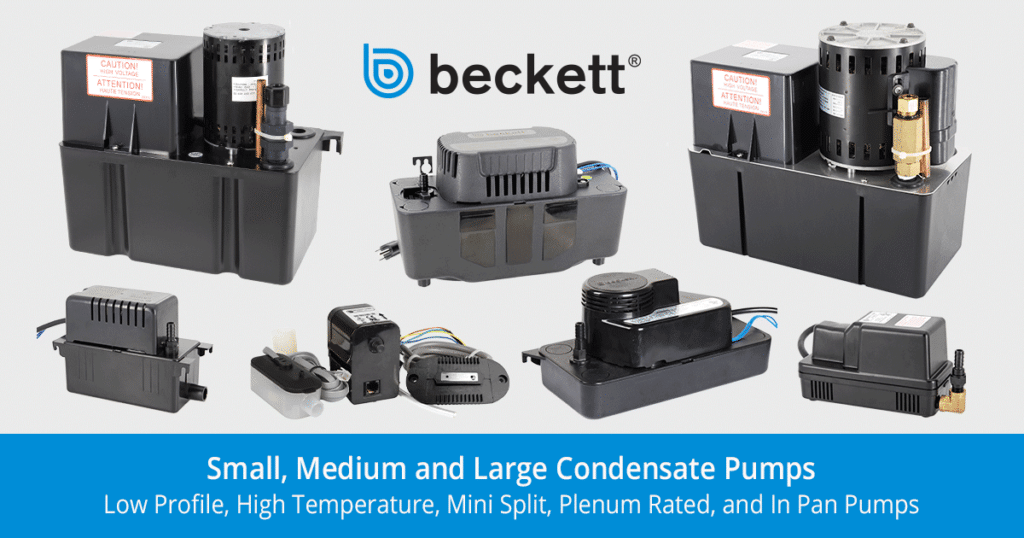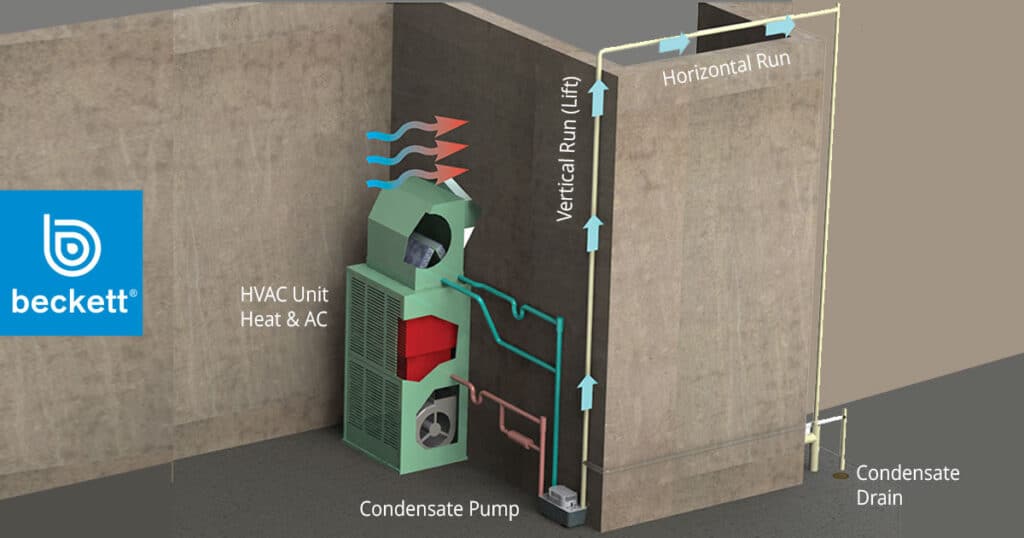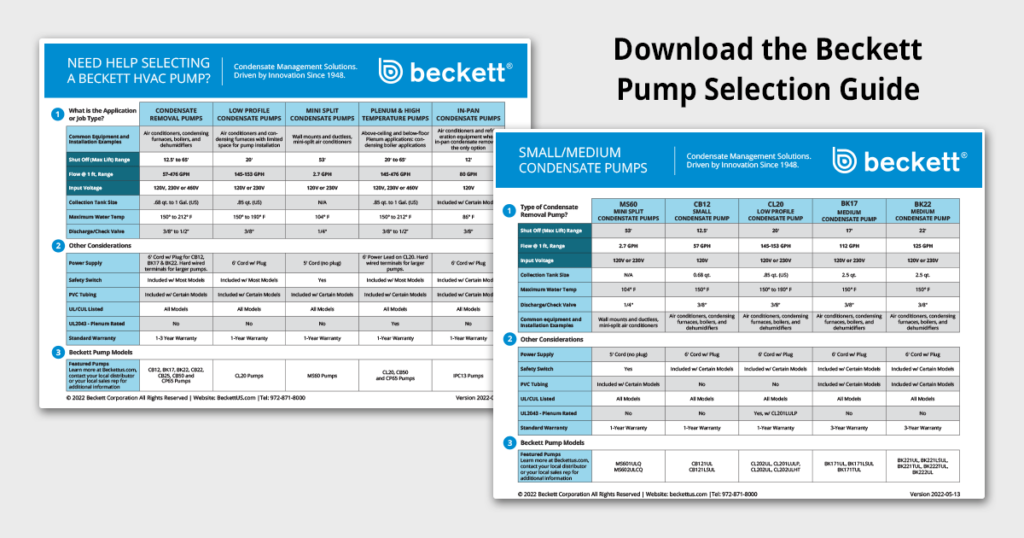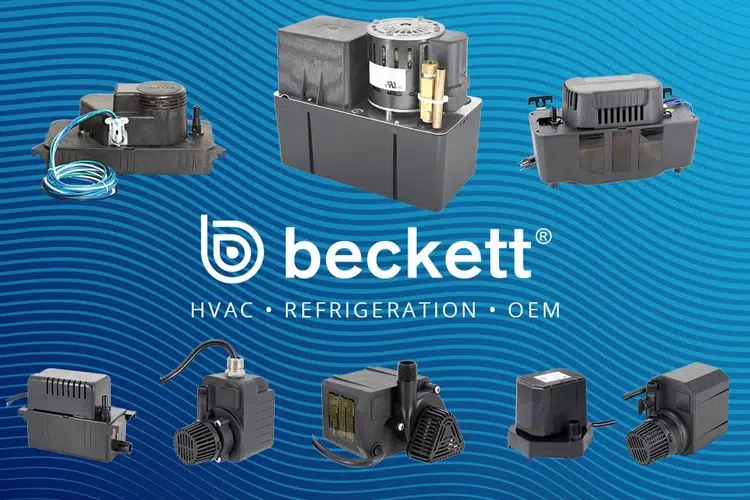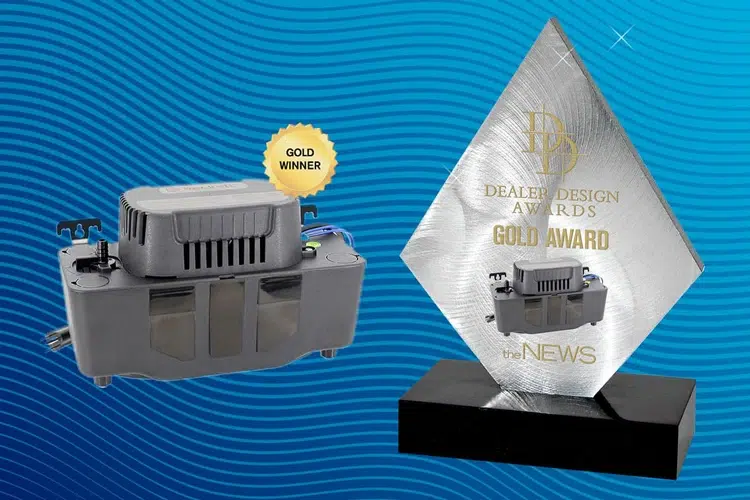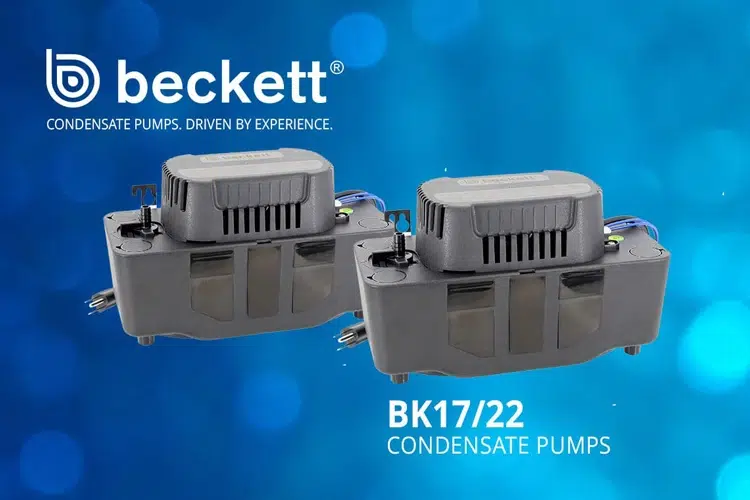How to Size and Choose a Condensate Pump
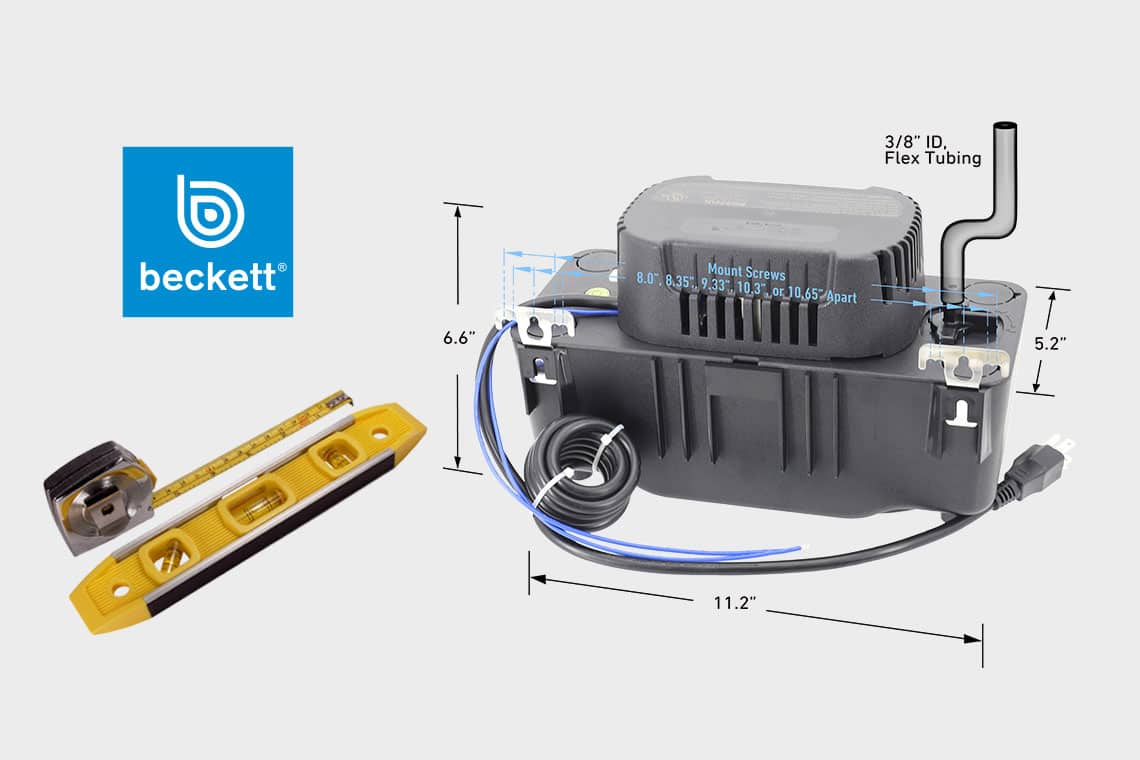
Looking to properly size and choose a condensate pump for your HVAC system? If so, keep reading this informative guide, where we’ll cover all the key elements for most applications.
A condensate pump is a specific type of pump used to automatically collect, move and direct the flow of HVAC condensate when gravity drainage is not possible or practical. If not properly collected and removed for HVAC equipment, condensate can damage buildings or property, including the growth of bacteria, mold, and algae, along with unpleasant odors.
Condensation (water) is commonly produced by HVAC equipment (heating and cooling), air conditioning systems, high-efficiency furnaces, condensing boilers, high-efficiency instant water heaters, dehumidifiers, steam humidifiers, refrigeration equipment, and others.
When selecting a new condensate pump, it’s important to have at least an accurate lift (or head) measurement, the required flow in GPH (gallons per hour), and the required voltage for the given application. Additionally, it is important that you or your contractor are familiar with the local building codes, which may dictate how a condensate pump and drain line should be sized and installed in your area.
Common Pump Selection Criteria
Condensate pumps are typically sized at three times (3x) the normal condensing or evaporation rate for your appliance (i.e. HVAC system). These guidelines are based on design and operating experience from HVAC professionals. However, upon proper application, units can be sized smaller (1.5-2x) depending on the condensing or evaporation rate of your HVAC equipment and the climate.
The following criteria should always be considered when selecting an appropriate condensate pump for your application. Keep in mind, there is no one size fits all, all applications are different.:
- Required lift: What is the flow rate (GPH) required at the maximum lift point?
- Power supply: Is your power source 115,/120, 230, or 460 volts?
- Power connection type: Grounded plug or direct wired?
- Flow rate: What is the GPH drain flow for your appliance and application?
- Max temperature: What is the maximum temperature of the drain condensate water from the appliance?
- Pump reservoir capacity: What size pump reservoir tank is needed to handle the condensing rate of your HVAC appliance and the application?
- Pump location: Most pumps should be mounted below the condensate source, but that depends on your application. Your pump type and model may vary depending on the equipment type or mounting location.
- Overflow safety shut off: Is an overflow safety switch needed? Some pump models include safety shut-off switches.
- Condensation water acidity: Mild acidic is ok, but corrosive water should be neutralized.
Note: Always consult a certified HVAC or plumbing professional for specific recommendations based on your application (equipment, climate, etc.) and local building codes.
Other Condensate Pump Considerations
Although some of the concepts are the same, sizing small fractional horsepower condensate pumps is different from sizing a large industrial pump used for commercial, industrial, municipal, or agricultural applications. Below we explain more about lift, head, friction loss, and other factors as they relate to condensate pumps used in residential and light commercial applications.
Static Head
This is the linear vertical measurement of the maximum height a specific pump can deliver water to the pump outlet. A pump can only deliver water to a maximum height because the weight of the water above the pump mechanism becomes greater than the forces which are attempting to operate the pump or move the impeller, piston, or diaphragm. By measuring vertically from the pump outlet to the point at which gravity takes over the flow of water in the drain line will give an accurate measurement of the pump’s head measurement.
Total Lift = Total Head = Static Head + Friction Head
Vertical Lift, also known as Static Head, Pump Head, or Lift, is the height that condensate water must travel as it moves through your discharge hose/pipe. To estimate this, measure the vertical distance from the condensate pump outlet to where the discharge pipe turns from vertical to horizontal.
As this distance increases, your condensate pump has to work harder to push/move the condensate through your discharge hose/pipe. When you’re selecting a condensate pump, determine its GPH (gallons per hour) capacity at the static head measurement for your application.
Friction Head, also known as Friction Loss
As water flows through your discharge hose/pipe, friction is created from water rubbing against the inside of the hose/pipe. This restricts the water flow, and your condensate pump must overcome this friction.
General Rules of Thumb about Friction Head
- A narrower discharge pipe will create more friction than a wider one
- Pipe fittings, like elbows and check valves, create friction
- The longer your discharge pipe, the more friction
- To minimize friction, a 1/4″ of downward slope is recommended for every 1′ of horizontal run
- Assume at least 6″ of head loss per 10′ of level horizontal run, and avoid dips if possible
If you think friction could be an issue for your condensate pump system, consult a certified plumber to find out how much friction is created in your discharge hose/piping. They can give you a Friction Head estimate, which you then add to the Vertical Lift (Static Head) to arrive at a Total Dynamic Head (e.g. Lift) that your condensate pump must be capable of producing.
Use this Total Dynamic Head figure when selecting a condensate pump to determine the pump’s capacity once it’s connected to your specific discharge hose/pipe system. Most condensate pump literature shows their pumping rates at different levels of lift or head.
Gallons Per Hour (GPH)
The GPH or gallons per hour of condensate the pump can remove in an hour should typically be 2-3 times the condensing rate of the HVAC equipment or other appliance. This is typical for smaller condensate collection tanks, on larger condensate collection tanks it may be worth a closer look because a capacity of 1.5-2 times the condensing rate may be adequate. The oversizing allows the pump to run less often under full load conditions. Refer to the owner’s manual that came with your furnace or condensing system to determine the amount of condensate your specific HVAC system may produce.
Voltage
Most residential systems require 115/120V power. Larger systems or light commercial systems may require 230 or 460V power for larger, higher-capacity applications.
Condensate Temperature
Depending on the manufacturer and model, most standard pumps will handle condensate from 86° to 150°F. In applications where condensate is above 150°F, you’ll likely need a high-temperature condensate pump rated for condensate temperatures from 190° to 212°F.
Physical Size or Profile
In applications where installation space is limited, a small, low profile or in pan condensate may be required. Make sure you consider where the pump will be mounted and if there are any space constraints to consider.
Mini Split Condensate Pumps
Designed for ductless mini split systems where there is limited room or power for a standard condensate pump. Mini split condensate pumps are specifically designed for mini split applications where they’re mounted inside, below or above the mini split air handling unit.
Other Resources
- Beckett Condensate Pump Selection Brochure
- Beckett online catalog
- Beckett HVAC product resources
- The Ultimate Guide to HVAC Condensate and Condensate Pumps
- Condensate Pump Cross Reference Guide
Final Thoughts
Obviously, there are many factors to consider when correctly sizing and choosing a condensate pump. If you’re replacing an existing pump, it’s likely more straightforward than a new application. If you don’t have the necessary experience, consulting a certified HVAC or plumbing professional for specific recommendations based on your application (equipment, climate, etc.) and local building codes are strongly recommended.
If you have questions about Beckett condensate pumps, visit our online catalog to learn more or call us at 866-466-4319.
